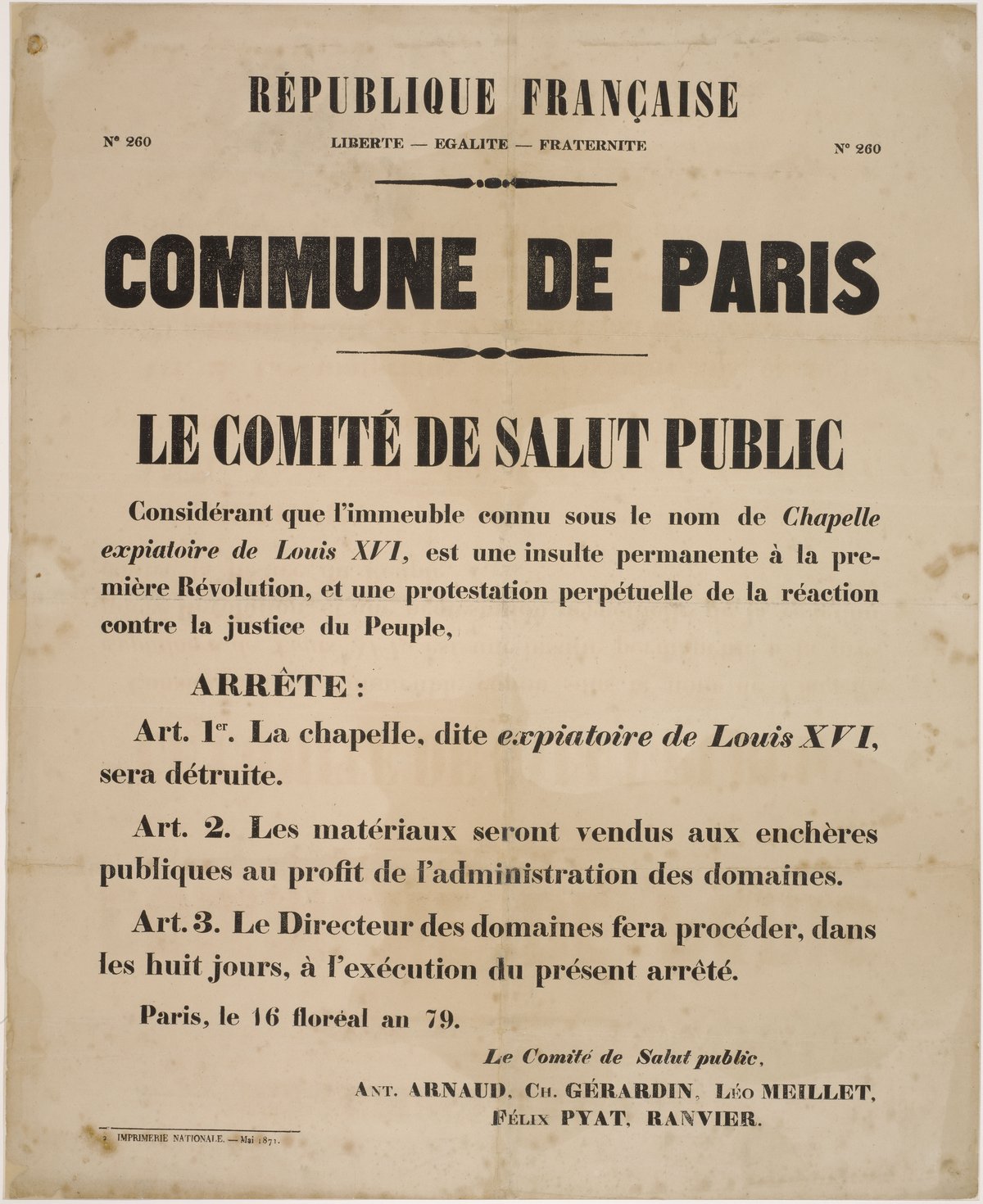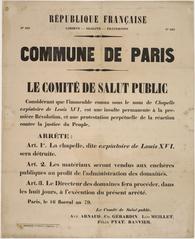
Chapelle Expiatoire: Visiting Hours, Tickets, and Historical Significance in Paris
Date: 14/06/2025
Introduction
Tucked away in the 8th arrondissement of Paris, the Chapelle Expiatoire stands as a poignant memorial dedicated to King Louis XVI and Queen Marie-Antoinette. Commissioned by Louis XVIII during the Bourbon Restoration, the neoclassical chapel occupies the former Cimetière de la Madeleine, where the royal couple and hundreds of other victims of the French Revolution were first buried in unmarked graves. The Chapelle Expiatoire offers visitors an immersive journey into France’s turbulent past, blending solemn architectural beauty, layered symbolism, and thought-provoking memory.
This comprehensive guide details the chapel’s historical context, architectural highlights, practical visitor information—including opening hours and ticketing—and tips for exploring one of Paris’s most evocative yet lesser-known historical sites. Whether you are passionate about history, drawn to architectural gems, or seeking a quiet place for reflection, the Chapelle Expiatoire is a must-visit destination.
Historical Context and Significance
From Revolutionary Upheaval to Royal Commemoration
The French Revolution, beginning in 1789, fundamentally reshaped France. The executions of King Louis XVI (January 21, 1793) and Queen Marie-Antoinette (October 16, 1793) on the Place de la Révolution (now Place de la Concorde) marked the end of the monarchy and the dawn of a new era. Their bodies were interred in the nearby Cimetière de la Madeleine, a burial ground also used for hundreds of other guillotine victims (Chapelle Expiatoire Official Site; Travel France Online).
After the fall of Napoleon and the restoration of the Bourbon monarchy in 1814, Louis XVIII sought to restore the dignity of his royal relatives and the monarchy itself. In 1815, the remains of Louis XVI and Marie-Antoinette were exhumed and moved to the Basilica of Saint-Denis. To “expiate” the regicide and honor their memory, Louis XVIII commissioned the Chapelle Expiatoire on the original site of their burial (Wikipedia; Chapelle Expiatoire Official Site).
Architectural Design and Symbolism
Pierre-François-Léonard Fontaine, a leading neoclassical architect, designed the chapel. Completed in 1826, the Chapelle Expiatoire features a minimalist neoclassical style, emphasizing solemnity and reflection. The approach to the chapel leads visitors through a tranquil garden (Square Louis XVI), past symbolic tombstones and winged hourglasses that memorialize the fallen (World in Paris; La Souris Globe-Trotteuse).
Inside, the Greek cross plan is illuminated by a central dome. The interior is adorned with two significant marble sculptures: “The Apotheosis of Louis XVI” by François Joseph Bosio and “Marie-Antoinette Supported by Religion” by Jean-Pierre Cortot. The crypt features a black marble altar marking the site where the royal remains were discovered, with inscriptions of the king’s will and the queen’s last letter (Chapelle Expiatoire Official Site; Introducing Paris).
The chapel’s architecture and art express themes of martyrdom, penance, and royalist remembrance, serving as a counterpoint to revolutionary memory and as a symbolic site for national reconciliation (Bonjour Paris).
A Contested and Preserved Heritage
Throughout the 19th and 20th centuries, the Chapelle Expiatoire was at the center of political and cultural debate. It survived threats of demolition, particularly during the July Revolution of 1830 and the Paris Commune in 1871, when its royalist symbolism made it a target. Over time, its meaning shifted from a site of expiation and royal commemoration to a protected national monument, recognized for its architectural merit and its role as a memorial to all those who suffered during the Revolution (Chapelle Expiatoire Official Site).
Since 1914, the chapel has been a listed historic monument, maintained by the Centre des Monuments Nationaux. Ongoing preservation ensures that both the building and its memory remain integral to Paris’s cultural landscape (Visit Paris Region).
Visiting the Chapelle Expiatoire: Practical Information
Opening Hours
- April to September: Tuesday to Saturday, 10:00–12:30 and 13:30–18:30
- October to March: Wednesday to Saturday, 10:00–12:30 and 13:30–17:00
- Closed: Sundays, Mondays, and public holidays
- Last Entry: 30 minutes before closing
Note: Hours may vary during special events or exceptional closures. Always check the official website before your visit.
Tickets and Admission
- Standard Admission: €7
- Reduced Admission: Available for students, seniors, EU residents under 26 (€5)
- Free Admission: Children under 18, EU residents under 26, disabled visitors and their companions (see official eligibility conditions)
- Purchase: Tickets can be bought on-site or online; online reservation is recommended during peak periods (Paris Pass)
Accessibility
- The chapel is wheelchair accessible; ramps and staff assistance are available by request (Bonjour Paris)
- Accessible restrooms and adapted services are provided
Visitor Experience
- Atmosphere: The site offers a quiet, reflective environment, ideal for contemplation and learning
- Information: Self-guided tours are available in multiple languages; guided tours may be available during special events
- Photography: Non-flash photography is permitted; tripods are not allowed to protect the artworks
- Facilities: Basic amenities and a peaceful garden setting
Getting There
- Address: 29, Rue Pasquier, 75008 Paris
- Metro: Saint-Augustin (Line 9), Miromesnil (Lines 9 and 13)
- Bus: Lines 32, 43, 49, 84, 94
- Nearby Attractions: Place de la Concorde, Church of La Madeleine, Musée Jacquemart-André, Galeries Lafayette (Paris Pass)
Security
- Security measures (Vigipirate) are in place, including bag checks—arrive early and plan accordingly
Preservation and Legacy
The Chapelle Expiatoire stands as a testament to the complexity of French memory—honoring not only the monarchy but also recognizing the broader human toll of the Revolution. Managed by the Centre des Monuments Nationaux, the site is carefully maintained, with restoration, archaeological work, and interpretive programs aimed at preserving both its physical structure and its evolving meaning (apollo-magazine.com; bonjourparis.com).
Annual commemorative events, such as the mass near January 21 (the anniversary of Louis XVI’s execution), continue to make the chapel a site of living memory for monarchists, historians, and the public alike (lecatho.fr).
Frequently Asked Questions (FAQ)
Q: What are the Chapelle Expiatoire visiting hours?
A: April–September: Tuesday to Saturday, 10:00–12:30 and 13:30–18:30; October–March: Wednesday to Saturday, 10:00–12:30 and 13:30–17:00.
Q: How much are tickets?
A: Standard admission is €7. Free for children under 18 and EU residents under 26; reduced rates apply for certain groups.
Q: Is the site accessible for people with disabilities?
A: Yes, the chapel is wheelchair accessible and staff can provide assistance.
Q: Are guided tours available?
A: Self-guided materials are available in multiple languages; guided tours may be scheduled during special events.
Q: Can I take photos inside?
A: Yes, non-flash photography is permitted.
Q: What other attractions are nearby?
A: The Church of La Madeleine, Place de la Concorde, and major Parisian museums and shops are within walking distance.
Plan Your Visit and Connect
To make the most of your visit, check the latest opening hours and ticket information on the official Chapelle Expiatoire website. Consider combining your trip with nearby Parisian landmarks, and use digital tools such as the Audiala app for guided tours and enhanced experiences.
Stay connected by following social media updates for event news and special tours, and browse related articles on Parisian heritage sites for further inspiration.
Sources
- Chapelle Expiatoire Official Site
- Travel France Online
- World in Paris
- Bonjour Paris
- Visit Paris Region
- Paris Pass
- La Souris Globe-Trotteuse
- Introducing Paris
- Apollo Magazine
- Lecatho.fr





































































































































































































































